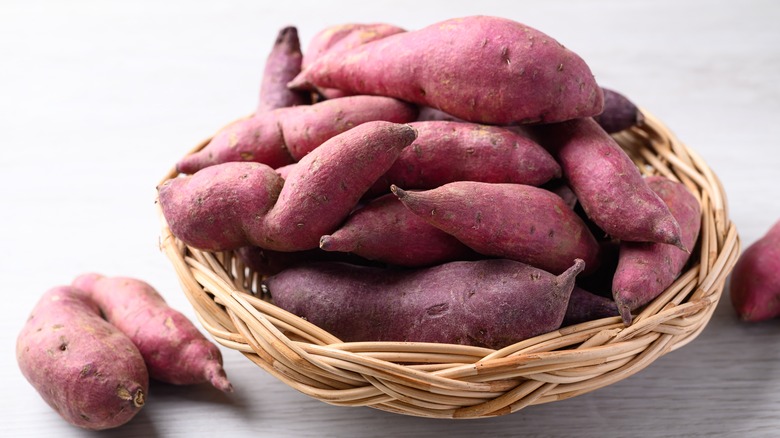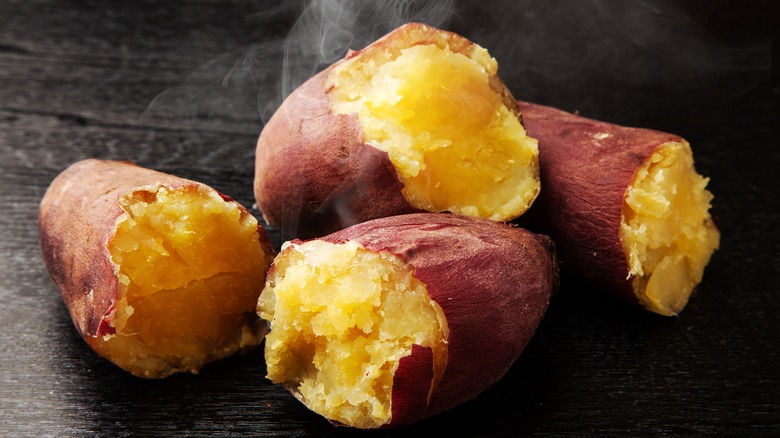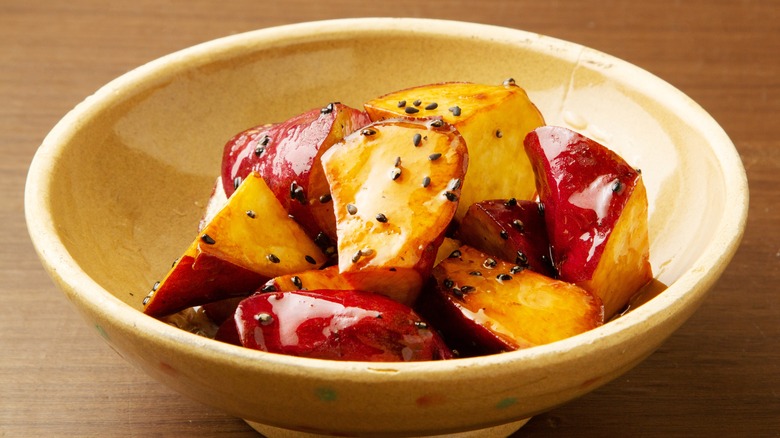American Vs Japanese Sweet Potatoes: What's The Difference?
It's Thanksgiving day, and the aroma of various foods is spreading through the house. You can smell the rolls rising in the corner, the stuffing cooking in the microwave, the deviled eggs being prepared; above all else, you can smell the turkey baking in the oven. But what else is in the oven? Only the most delicious, delectable item for Thanksgiving — sweet potatoes. Of course, to make these, you just go to the store and grab some sweet potatoes, brown sugar, and marshmallows. If you're like me, you wouldn't think twice about what sweet potatoes to grab, right? Well, today, I (and maybe you) learned that there are hundreds of different sweet potatoes (and none of them are yams). Let's just focus on two types for now: "grocery store" and Japanese sweet potatoes.
When you go to the store, you are likely to find one of three varieties of sweet potato, which include the Beauregard, the jewel, and the garnet. The Beauregard is what most of us are likely familiar with, as it is the most commonly grown variety in the states; it's oblong with reddish-orangish skin and a bright orange inside. These sweet potatoes are very American, growing well from North to South. Japanese sweet potatoes are also oblong, but their skins are more purplish-red, and the insides are usually between a white and a yellow color. Although they are Japanese sweet potatoes, they are actually grown in South America (but commonly used in Japanese cuisine).
Japanese sweet potatoes are softer and nuttier
One big difference in Japanese sweet potatoes is the texture; American sweet potatoes have a 77% moisture content, making them pretty wet, while Japanese ones are drier, with a moisture content around 70%. In practical terms, this results in the Japanese variety having a much fluffier texture, closer to that of a regular potato, than "regular" sweet potatoes, which have a texture similar to a pumpkin. Japanese sweet potatoes are also very dense inside, so the cooking process may take a bit more time. Unlike other sweet potatoes, though, they aren't likely to get soggy or overly wet during the cooking process.
The flavor of Japanese sweet potatoes is a sweet one (hence the name), often said to be sweeter than a regular orange sweet potato. At the same time, some describe the taste as being nutty, close to that of a chestnut; in Japan, these sweet potatoes are even touted as a special fall flavor (similar to pumpkin spice in America). In terms of choosing a sweet potato at the store, the method is pretty similar for both varieties: choose ones that are firm and smooth, with a vibrant, consistent color, without noticeable blemishes or marks. Both varieties should be stored in a cool, dry, dark place (like a cupboard around 50-55 degrees Fahrenheit). Stored this way, both can last up to a month.
Recipe ideas using Japanese sweet potatoes
If you want to try a classic Japanese recipe, try yaki imo. Yaki imo is simply Japanese sweet potatoes that have been baked. While they're easy to make, the method can affect how the finished product will taste; the main methods are baked wrapped in foil versus baked "naked." When baked in foil, the flavor is plainer, but the skin is quite soft, and the inside is fall-apart fluffy. When baked without foil, the flavor is a lot sweeter, but the skin is tougher (though easier to peel off), and the inside is flakier. Both methods result in delicious sweet potatoes, so experiment and decide based on your tastes. If you want a more on-the-go snack, try hoshi imo or dried sweet potatoes. The sweet, nutty flavor remains, and the dried pieces can act almost as a stand-in for candy.
If you want a sweeter treat, try making daigaku imo. These candied sweet potatoes are made by deep-frying bite-sized sweet potatoes, covering them in a candy coating (made with soy sauce, sugar, mirin, and water), and topping them with black sesame seeds. If you want a true fusion dessert, try crème brûlée made inside a Japanese sweet potato. Made popular by Tokyo snack bar Imo Pippi, this recipe combines the sweet custard and caramelized sugar of creme brulee with the sweet, nutty flavors (which become stronger after baking/roasting) of Japanese sweet potatoes. No matter what you decide to make, be sure to try Japanese sweet potatoes for a new sweet snack.


